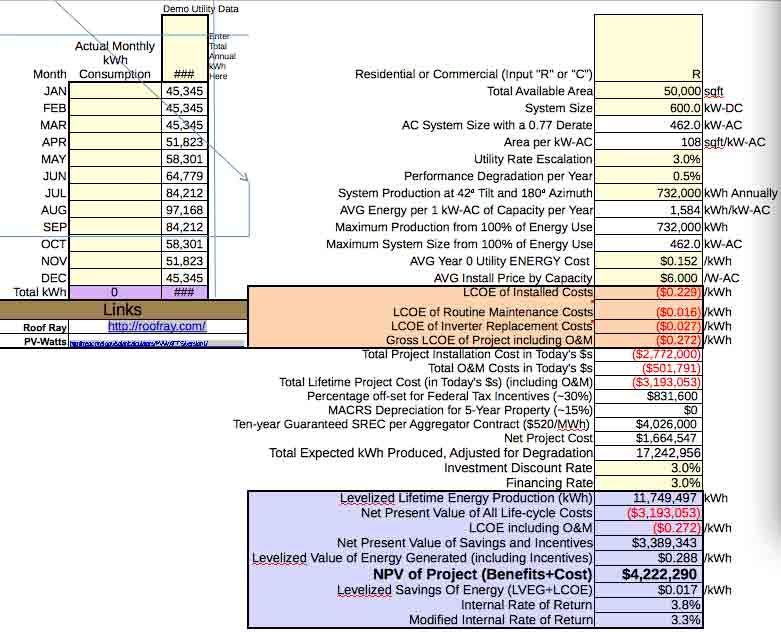To determine neighborhood power plant size for the purpose of this BCA, we'll apply data for average residential electric use, as distinguished from commercial use, because Massachusetts requires a minimum of ten residents to qualify for neighborhood sharing of NEM credits [27]. Thus, we'll assume the average 610 kWh/month/household, as reported by U.S. Energy Information Administration for Massachusetts Residential Electric Usage (2009) [30]. Our total annual electric consumption for 20 residents is then 146,400 kWh/yr, requiring almost 1500 square feet for the photovoltaic (PV) array, which might be accommodated on a single rooftop. We'll also assume PV arrays with ideal tilt (42 degrees latitude) and azimuth (180 degrees).
PV Watts Performance Calculator for Grid-Connected PV Systems [31] tells us we'll need a 120 kW-DC system to meet our AC requirement for 20 average households. [32]
The average number of residents and businesses enrolled with any particular PPS will vary, and for our illustration we'll assume a total enrollment of 100 residents in a single neighborhood system, requiring five separate arrays, in able to achieve economy-of-scale in installation. Thus, to supply 100 residents, the total initial energy demand is 732,000 kWh/yr. We'll build for 100% of that demand so that efficiency upgrades will enable expansion without additional production costs. We'll assume a conservative installation cost 10% higher than current prices (2012) for Massachusetts. We also are averaging energy costs at the western and eastern ends of the State, which are highest and consequently where we'll concentrate development; and assuming that half of production will be distributed and thus incur that additional cost. Our spreadsheet analysis (Complete SunMoney-Massachusetts NPV Spreadsheet is available in ods format [33]) suggests this initial pilot project will yield a positive Net Present Value (NPV) of about $4.22 million, or $42,200 per customer, from a total lifetime cost of about $14,500 per customer (This is over 25 years).

Image from SunMoney-Massachusetts spreadsheet analysis [34]. Complete SunMoney-Massachusetts NPV Spreadsheet is available in ods format [33].
This NPV is an excellent result, but of course other conditions are possible. For example, an average 5% utility rate increase delivers a 20% higher NPV, while a 5% discount rate lowers the NPV by 10%. In fact, the NPV might be far better or somewhat worse, for while the incentives applied in this analysis are guaranteed minimums for projects secured through 2013 [35], actual utility and discount rates are unpredictable because of the uncertain costs of fuel, unknown future incentives, and many other factors. However, some installers now accept the promise of the Federal incentive towards payment, and some banks now accept Massachusetts SREC guarantees as collateral, so the general assumptions of those providing financing for solar plants today are NPV-positive. Consequently, this analysis assumes the 3% value in anticipation of unquantifiable future support for renewable energy, such as the range of support that might emerge because of the advantages to sourcing energy in neighborhoods where it is consumed, which is the ultimate net-zero energy strategy [36] [37].
Our neighborhood PPSs and Reconomy marketplaces will provide real-time data on individual, household, and community use of SunMoney local currency and the energy we provide, allowing us to measure, evaluate, and adjust our program as necessary towards achieving maximum end-use energy efficiency, net-zero community-scale energy performance, and community self-reliance. And by demonstrating results from our pilots, we'll create a demand for SunMoney and the clean energy from People Power Stations that motivates participation everywhere.
Through our energy-money value loop, money that once left communities to import energy will now circulate continuously in marketplaces controlled by our members within their communities. This accomplishes not only energy self-reliance, but also the financing of development of every product and service that can be sourced locally -- a strategy for sustainable prosperity both locally and globally.